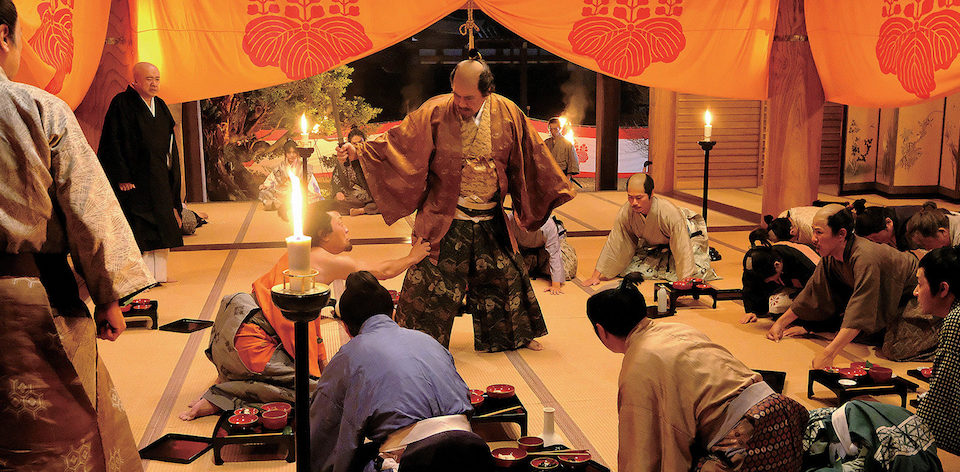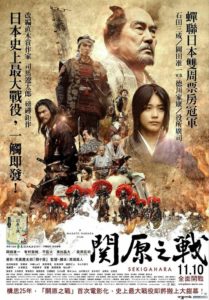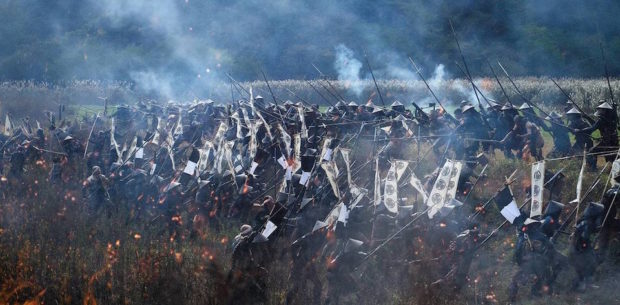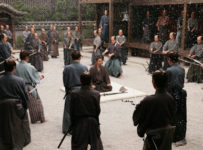The Battle of Sekigahara is one of the anchor points of early modern Japanese history. Depicted in novels, manga, films, and even video games, it was the decisive 6-hour battle that preceded the Tokugawa shogunate, the last feudal Japanese military government that lasted 260 years.
So with SEKIGAHARA (関ヶ原), veteran critic, actor, and director Masato Harada has created a modern take on the battle that is suitably epic. Where Hiroshi Inagaki featured the battle at the beginning of his classic Samurai Trilogy, Harada uses Ryôtarô Shiba’s three-volume novel to show the political and military machinations that led up to the historic confrontation.
There’s a lot going on in the first half of the film, and Harada impressively manages to coral the hundreds of characters and story threads down to a mere few dozen. It’s no less complicated, and you will get lost in the names and politics unless you’re already familiar with the history. Yet the essentials boil down to an ultimate confrontation between Ishida Mitsunari (Junichi Okada) and Tokugawa Ieyasu (Yakusho Koji), and the various people around them working for and against their interests.
There’s honestly so much to take in for the first two-thirds of the film that it’s difficult to make a proper assessment on a single viewing. Harada has enough material here for several seasons of television, which might explain him rapidly running through the years 1577 to 1598. Yet there’s a lot to like, mostly thanks to Harada’s penchant for finding the most politically dramatic character moments to highlight.
In some ways it’s all just window dressing for the battle itself, one that dominates the last 40 minutes or so of the film. Here Harada’s attention to detail comes to the fore, mirroring the frenetic build-up and spent aftermath of the real deal. From that perspective, it is easily up there with the best war films of all time, as Harada orchestrates a cast that may not number the 180,000 men on the battlefield, but always feels like it does.
Takahide Shibanushi’s (Villon’s Wife) photography fills every inch of his widescreen canvas with pristine depictions of impeccable period accuracy. A drunken party at Toyotomi Hideyoshi’s palace, for example, is dripping with colourful costuming (and booze). Having worked with Harada on the Second World War epic The Emperor in August (2015), the duo craft what we imagine is as close to being in 1600 as we’re ever going to be. Unless we invent time travel, and our priorities would be elsewhere in that instance.
Despite some narrative misgivings with this film, which are an inevitability when dealing with a story this size, SEKIGAHARA unquestionably feels like a big film. We’ve seen Japanese cinema aim for large-scale and fail on the budget allocation, but Harada’s film never looks like every yen was wisely spent. Here’s hoping the rest of this fascinating slice of history will be told elsewhere.
[stextbox id=”grey” bgcolor=”F2F2F2″ mleft=”5″ mright=”5″ image=”null”] 2017 | Japan | DIRECTOR: Masato Harada | WRITERS: Based on a novel by Ryōtarō Shiba | CAST: Junichi Okada, Kasumi Arimura, Takehiro Hira, Masahiro Higashide, Kōji Yakusho | DISTRIBUTOR: Toho, Asmik Ace, New York Asian Film Festival (US) | RUNNING TIME: 150 minutes | RELEASE DATE: 30 June 2018 (NYAFF)[/stextbox]
2017 | Japan | DIRECTOR: Masato Harada | WRITERS: Based on a novel by Ryōtarō Shiba | CAST: Junichi Okada, Kasumi Arimura, Takehiro Hira, Masahiro Higashide, Kōji Yakusho | DISTRIBUTOR: Toho, Asmik Ace, New York Asian Film Festival (US) | RUNNING TIME: 150 minutes | RELEASE DATE: 30 June 2018 (NYAFF)[/stextbox]






